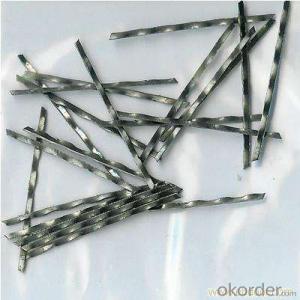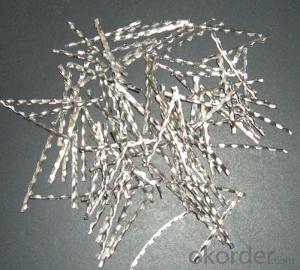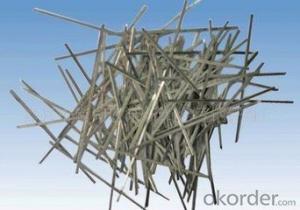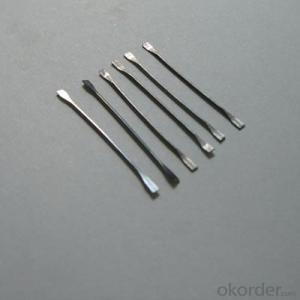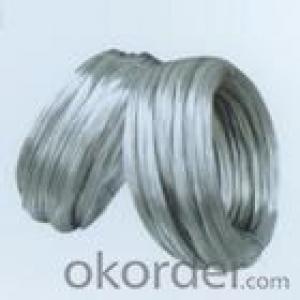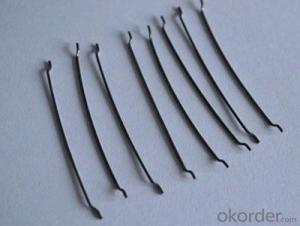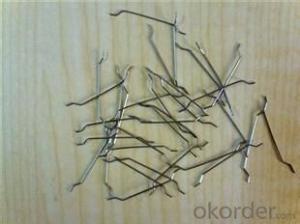Steel Fiber Loose From Flat Xorex Type From China
- Loading Port:
- Tianjin
- Payment Terms:
- TT OR LC
- Min Order Qty:
- 5 kg
- Supply Capability:
- 30000 kg/month
OKorder Service Pledge
OKorder Financial Service
You Might Also Like
Quick Details
Place of Origin: Jiangsu, China (Mainland)
Model Number: HT-MC
Material: Color Steel
certificated: ISO 9001
Specifications
Applications
Industrial Floorings, Pavements
Highways, Roadways and Bridges.
Seismic Resistant structures. ( Dams)
Explosive and Impact resistance Structures
Precast Structures and elements
Shotcrete in Mines / Tunnels
Quality Approvals
Manufactured according to ASTM A820 M04 Type 1 Standard
ISO 9001:2008 Certified
Technical Specifications
Material Type: Low Carbon Drawn Wire
Appearance and form: Clear, bright, semi-flat and undulated along the length.
Tolerances – _+ 5 to 8%
Young Modules – 210 N/mm2
Thickness- 0.55 mm
Length - 25 mm to 60 mm.
Picture

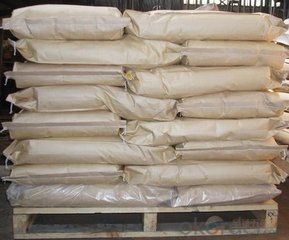
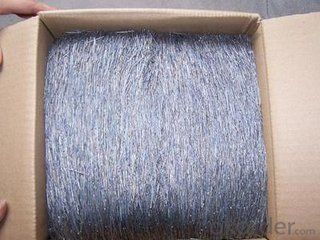
Steel fiber
FAQ
certificated: ISO 9001
Technical advantages of Daye steel fiber:
A. Improve mechanical performance of concrete
B. Provide uniform distribution throughout concrete with excellent mixing
C. No balling or caking by adopt correct mixing method
D. Reduce concrete volume
E.Save construction time and cost
F.Reduce excavation volume
G.Available for jointless floor.
- Q:How does the addition of melt extract stainless steel fiber affect the permeability of concrete?
- The addition of melt extract stainless steel fiber can significantly affect the permeability of concrete. Stainless steel fibers are typically added to concrete mixtures to enhance its mechanical properties and improve durability. When stainless steel fibers are incorporated into concrete, they create a three-dimensional network within the structure, reducing the size and number of capillary pores. This network acts as a barrier to the movement of water and other substances through the concrete matrix, thereby reducing the permeability of the material. The presence of stainless steel fibers also enhances the cohesion and interlocking of the concrete particles, resulting in a denser and more compact structure. This densification further restricts the movement of water and reduces the permeability. Additionally, stainless steel fibers can help to minimize cracking in concrete. By providing additional reinforcement and improving the tensile strength of the material, they can help to prevent the formation of cracks that could potentially allow water and other substances to penetrate the concrete. Overall, the addition of melt extract stainless steel fiber to concrete can significantly reduce the permeability of the material, making it more resistant to the ingress of water and other potentially harmful substances. This can greatly enhance the durability and lifespan of concrete structures, particularly in environments where moisture penetration is a concern, such as in marine or high-moisture areas.
- Q:Can melt extract stainless steel fiber be used in roller-compacted concrete applications?
- Roller-compacted concrete (RCC) applications can indeed utilize melt extract stainless steel fiber. Unlike traditional placement and compaction methods, RCC employs vibratory rollers to compact a specialized concrete mixture. The inclusion of stainless steel fibers in RCC has the potential to improve its performance and enhance its mechanical properties. Melt extract stainless steel fibers are specifically engineered to offer high tensile strength, durability, and crack resistance. These attributes render them suitable for use in RCC applications that prioritize strength and crack resistance. To reinforce the material and prevent crack formation, the stainless steel fibers are evenly dispersed throughout the concrete mixture. This reinforcement also enhances the overall toughness and ductility of the RCC, thereby increasing its resistance to impact and dynamic loads. Moreover, melt extract stainless steel fibers exhibit corrosion resistance, which is particularly crucial in environments where the RCC may encounter harsh conditions such as excessive moisture or chemical exposure. In conclusion, melt extract stainless steel fibers can effectively improve the mechanical properties, durability, and crack resistance of roller-compacted concrete applications.
- Q:Can melt extract stainless steel fiber be used in foundation slabs?
- Yes, melt extract stainless steel fiber can be used in foundation slabs. These fibers provide reinforcement and improve the overall strength and durability of the concrete. They are commonly used in industrial and commercial applications where heavy loads and high traffic are expected. The stainless steel fibers are resistant to corrosion and can withstand harsh environmental conditions. They also help to control cracking and improve the overall performance of the foundation slab.
- Q:How does melt extract stainless steel fiber enhance the durability of composite materials?
- Melt extract stainless steel fiber enhances the durability of composite materials by providing reinforcement and increasing their strength. The stainless steel fibers are embedded within the composite matrix, improving its mechanical properties such as tensile strength, toughness, and resistance to cracking or breaking. This added reinforcement helps the composite material withstand external forces, impacts, and wear, ultimately enhancing its overall durability and lifespan.
- Q:Can melt extract stainless steel fiber be used in earthquake retrofitting?
- Indeed, melt extract stainless steel fiber proves to be a valuable asset in earthquake retrofitting endeavors. Renowned for its robustness and resilience, stainless steel fibers present themselves as an ideal substance for fortifying structures against seismic impacts. By incorporating these fibers into concrete or other construction materials, one can significantly enhance their ability to withstand tensile stresses and prevent cracks from forming during an earthquake. Moreover, the exceptional corrosion resistance of stainless steel guarantees the longevity and efficacy of the retrofitting solution. Consequently, melt extract stainless steel fiber emerges as an indispensable element in earthquake retrofitting initiatives.
- Q:What is the effect of melt extract stainless steel fiber on the modulus of deformation of concrete?
- The incorporation of melt extract stainless steel fiber in concrete generally leads to an increase in the modulus of deformation. This is due to the high tensile strength and superior bonding properties of stainless steel fibers, which enhance the overall structural integrity and stiffness of the concrete matrix. Additionally, these fibers also help to reduce cracking and enhance the flexural strength and durability of the concrete.
- Q:Can melt extract stainless steel fiber be used in roller-compacted concrete (RCC)?
- Yes, melt extract stainless steel fiber can be used in roller-compacted concrete (RCC). RCC is a type of concrete that is compacted using rollers, which provides a denser and more durable finished product. The addition of stainless steel fibers in RCC can enhance its mechanical properties, such as resistance to cracking and improved flexural strength. Melt extract stainless steel fibers are produced by melting stainless steel and then rapidly extracting it into fine fibers. These fibers have high tensile strength, corrosion resistance, and can effectively distribute stresses within the concrete matrix. As a result, they can enhance the performance of RCC by improving its resistance to shrinkage, impact, and fatigue. Furthermore, melt extract stainless steel fibers are easily dispersed in the concrete mixture and can be evenly distributed throughout the RCC during the compaction process. This ensures that the fibers are well-bonded with the concrete matrix, providing uniform reinforcement and preventing the formation of cracks. In summary, the use of melt extract stainless steel fiber in roller-compacted concrete is a suitable option to enhance its mechanical properties and overall durability. However, it is important to consult with concrete experts and conduct proper testing to determine the appropriate dosage and fiber length for the specific RCC application.
- Q:What is the effect of melt extract stainless steel fiber on the dimensional stability of concrete?
- The dimensional stability of concrete is significantly affected by the incorporation of melt extract stainless steel fiber. These fibers are introduced into the concrete mixture during the mixing process, ensuring their even distribution throughout the material. One of the primary advantages of melt extract stainless steel fiber lies in its capacity to enhance the overall strength and durability of concrete. Acting as reinforcement, these fibers provide additional tensile strength to the material, effectively preventing cracking and shrinkage, which are common problems in concrete structures. By mitigating cracking and shrinkage, melt extract stainless steel fiber betters the dimensional stability of concrete. As a result, the material retains its original shape and size over time, even when subjected to fluctuating environmental conditions such as temperature variations or exposure to moisture. In addition, the inclusion of these fibers improves the overall performance of concrete in terms of impact resistance, abrasion resistance, and fatigue resistance. Consequently, it proves particularly advantageous in applications where the concrete will experience heavy loads or frequent wear and tear. Moreover, melt extract stainless steel fiber can also augment the fire resistance of concrete. Due to their high melting point, these fibers impede the rapid spread of fire and the subsequent structural collapse. This attribute is particularly crucial in buildings and structures where fire safety is a paramount concern. Overall, the utilization of melt extract stainless steel fiber in concrete significantly enhances its dimensional stability, strength, and durability. Consequently, it results in the creation of longer-lasting and more reliable concrete structures that can effectively withstand various environmental and mechanical forces.
- Q:Can melt extract stainless steel fiber be used in lightweight aggregate concrete?
- Certainly, lightweight aggregate concrete can make use of melt extract stainless steel fiber. Typically, stainless steel fibers are incorporated into concrete blends to enhance qualities like toughness, flexibility, and longevity. Lightweight aggregate concrete, as opposed to conventional aggregate concrete, employs lightweight aggregates, leading to decreased density and weight. By incorporating stainless steel fibers into lightweight aggregate concrete, its mechanical strength and crack resistance can be significantly improved, rendering it a viable choice for diverse applications. Nevertheless, it is crucial to guarantee the proper distribution and amalgamation of the stainless steel fibers within the concrete to attain the desired advantages.
- Q:How does the addition of melt extract stainless steel fiber affect the creep behavior of concrete?
- Concrete's creep behavior is positively affected by the inclusion of melt extract stainless steel fiber. Creep refers to the gradual deformation of concrete over time under a constant load and is a significant issue in structural applications since it can result in long-term deformation and structural failure. By incorporating melt extract stainless steel fibers into the concrete mix, the material's overall mechanical properties are improved. The fibers function as reinforcement, imparting additional tensile strength and enhancing the concrete's resistance to cracking and deformation. Moreover, the steel fibers play a role in reducing concrete's overall creep. They act as internal support, opposing the movement and redistribution of stresses within the concrete matrix. This reinforcement effect aids in the more even distribution of the applied load, thereby diminishing the potential for long-term deformation. Additionally, melt extract stainless steel fibers enhance the durability of concrete by boosting its resistance to environmental factors like shrinkage, thermal cycling, and aggressive chemicals. This heightened durability contributes to the long-term stability and performance of concrete structures. In conclusion, incorporating melt extract stainless steel fibers into concrete enhances its creep behavior by improving its mechanical properties and reducing the likelihood of long-term deformation. This reinforcement effect results in increased structural integrity and durability, making it an effective solution for applications where creep resistance is a concern.
1. Manufacturer Overview |
|
|---|---|
| Location | |
| Year Established | |
| Annual Output Value | |
| Main Markets | |
| Company Certifications | |
2. Manufacturer Certificates |
|
|---|---|
| a) Certification Name | |
| Range | |
| Reference | |
| Validity Period | |
3. Manufacturer Capability |
|
|---|---|
| a)Trade Capacity | |
| Nearest Port | |
| Export Percentage | |
| No.of Employees in Trade Department | |
| Language Spoken: | |
| b)Factory Information | |
| Factory Size: | |
| No. of Production Lines | |
| Contract Manufacturing | |
| Product Price Range | |
Send your message to us
Steel Fiber Loose From Flat Xorex Type From China
- Loading Port:
- Tianjin
- Payment Terms:
- TT OR LC
- Min Order Qty:
- 5 kg
- Supply Capability:
- 30000 kg/month
OKorder Service Pledge
OKorder Financial Service
Similar products
New products
Hot products
Related keywords
